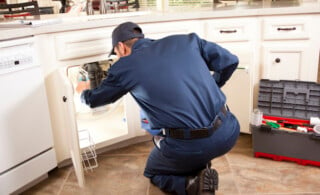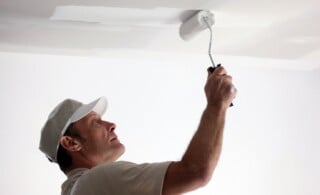What is mercury?
Mercury is a metallic element that is liquid at room temperature. You may know it as “quicksilver,” though it was originally named hydrargyrum — hence its chemical symbol, Hg. Mercury occurs naturally in the earth’s crust and has three forms: elemental, inorganic, and organic.
| Mercury Compound | About | Exposure Risks |
|---|---|---|
| Elemental (Metallic) |
|
|
| Inorganic |
|
|
| Organic |
|
|
What are the health risks of mercury?
When contained in glass or metal, like a thermometer or a light bulb, mercury poses no risk. When released through a break or a spill, however, mercury is toxic to humans. Even in small amounts, it can affect the nervous, digestive, and immune systems, as well as the lungs, kidneys, skin, and eyes in unhealthy ways.
The health risks of mercury vary depending on which form it takes, as well as the amount, length, and type of exposure — inhalation, ingestion, or through the skin. Generally, unborn children and people who are regularly exposed to mercury, usually as part of their occupation, are at the highest risk.
| Type | Method of Exposure | Health Risks |
|---|---|---|
| Elemental (Metallic) |
|
|
| Inorganic |
|
|
| Organic |
|
|
Does my home have mercury?
The Environmental Protection Agency (EPA) monitors mercury levels in water and the outside air to ensure it meets acceptable standards. Therefore, if there is mercury in your home, it is most likely present in the elemental form–inside of appliances, electronics, and other household items.
As long as these items remain intact, the mercury inside poses no threat. If they break or crack, however, they can release toxic vapor. That’s why it’s important to know what items in your home may contain it.
Though mercury is no longer used in most products, it does have some modern uses, including LCD screens on computers and televisions and fluorescent light bulbs. In older homes, mercury may be present in both outdated items and items you still use, including:
- Antiques: barometers, clock pendulums, mirrors, vases, and organs
- Older electric appliances: chest freezers, space heaters, clothes dryers, irons, and washing machines
- Gas appliances: ovens, water heaters, furnaces, pool heaters, and some RV appliances
- Auto Parts: switches and relays in cars manufactured before 2003 and wheel balancers on trucks, motorhomes, and motorcycles
- Batteries: button cell batteries and mercuric oxide batteries
- Electronics: LCD screens and monitors, laptop screen shutoffs, switches in TVs manufactured before 1991
- Jewelry: some jewelry imported from Mexico contains liquid mercury encased in glass
- Light bulbs: fluorescent bulbs, compact fluorescent light bulbs (CFLs), high intensity discharge (HID) lamps, ultraviolet (UV) lamps, neon lights
- Pharmaceuticals: antibiotics, blood pressure cuffs, contact lens solution, dental amalgam, diuretic, ear and eye drops, eye ointment, hemorrhoid relief ointment, Mercurochrome, nasal spray, and thermometers
- Sports equipment: recoil suppressor unit in rifles, stabilizers in archery bows, and switches in fishing tip-up lights
- HVAC systems: gas pressure regulators, boiler heating systems, Honeywell heat generators, and thermostats
How Do I Dispose of Products Containing Mercury?
The best way to ensure the mercury in your home does not become a problem for you and your loved ones is to practice proper disposal of these items. More often than not, these products have special recycling instructions. Do not dispose of them in your regular trash or recycling bins.
Many states and local agencies have recycling and hazardous waste programs in place to help residents properly dispose of mercury-containing items. Some local thrift stores, electronics stores, and home improvement stores may also take back common household items like light bulbs, batteries, televisions, and computers. The EPA recommends searching for a recycling program near you by typing in your zip code and the item you need to dispose of at Earth911.com.
In addition to keeping your family safe from spilled mercury and its vapors, proper disposal ensures products don’t end up in the landfill or incinerator. When this happens, the toxic substance can leak into the groundwater and soil, and vapors can end up in the air.
What do I do in the event of a mercury spill?
As long as there are items in your home that contain mercury, there is the possibility of exposure. In most cases, this happens when a product breaks or cracks. If this happens to you, it’s important to know what to do — and what not to do — to reduce your risk of inhaling or ingesting. The first step to cleaning up a spill is to call your local health or fire department and follow their instructions. Otherwise, how you handle a spill will vary depending on the amount of mercury.
However, there are certain things you should never do after a mercury spill:
- Never vacuum it. This will increase exposure by releasing it into the air.
- Never sweep it up with a broom. This will create smaller droplets and spread them out.
- Never pour it down the drain. It may lodge in the pipes, risking exposure during future work or repairs. It can also pollute your septic tank or sewage treatment plant.
- Never track it around your home. If your shoes or clothes are contaminated, remove and dispose of them immediately.
Small Spills
To clean up a small spill, defined as the amount in a mercury thermometer or less, follow this protocol:
- Open all doors and window to the outside. Close all interior doors.
- Do not allow children to help clean the spill.
- Remove other people and pets from the area, being careful to avoid contact with it on the way out.
- An adult may clean the substance from wood, linoleum, tile, and other smooth surfaces. You must throw away contaminated, absorbent items curtains and upholstery. Be prepared to cut and remove the affected carpet.
You’ll need:
- Zip-top plastic baggies
- Trash bags (2-6 mils thickness)
- Rubber, nitrile, or latex gloves
- Paper towels
- Cardboard or a squeegee
- Eyedropper
- Duct tape, or shaving cream and a small paint brush
- Flashlight
- Powdered sulfur (optional)
Instructions to remove small spill:
- Put on gloves.
- Remove broken objects, place in paper towel, and seal in zip-top bag.
- Use a squeegee or piece of cardboard to gather visible beads into larger balls, using slow, sweeping motions. Turn down the lights and inspect the entire room with a flashlight, paying special attention to cracks in the floor.
- Draw up the mercury beads in the eyedropper, and squeeze them onto a damp paper towel. Seal the paper towel into a zip-top bag.
- Use duct tape to pick up remaining beads, or put shaving cream on paint brush and gently pat the area to pick up smaller beads.
- Place all materials used for clean-up in zip-top bags.
- Label all bags as directed by the local health or fire department.
- Optional: use the powdered sulfur to absorb beads that are invisible to the naked eye. Be careful not to breathe in the powder.
After you have cleaned up the spill, be sure to:
- Call the local health department, fire department, or waste authority. Ask them how to dispose of the mercury waste according to local, state, and federal laws.
- Continue to vent the area to the outside, leaving windows open for at least 24 hours after you clean up. Keep pets and children out of the area during this time. If you feel sick, visit a doctor right away.
- Call a professional air quality service to test your home for mercury vapors. You can also contact your local environmental or health department for contractors in your area.
Larger Spills
In the event you spill more mercury than you find in a thermometer, you should not attempt to clean the spill yourself. Instead, call your local health department or fire department as soon as possible. If the quantity is greater than one pound, or two tablespoons, you must call the National Response Center to report the spill at 800-424-8802.
In either case, your initial response should be to:
- Remove people and pets from the area, careful to avoid contact with the substance on the way out.
- Open all doors and window to the outside. Close all interior doors.
- Turn down the temperature in your home.
- Leave the area.
Should I test my home for mercury?
If your home is new enough that it has never contained any appliances with mercury, and you can attest to the fact that none has ever been spilled, you probably don’t need to test your home. However, many homeowners choose to perform an air quality test as part of the inspection during the home-buying process.
You may want to test your home for mercury vapors if a spill has ever occurred in the home, especially if testing didn’t occur at the time of the spill. The substance easily travels and can be tracked on shoes and clothes to other areas of the home. In some cases, vapors are still present decades after the initial spill.
You should also test your home if anyone in your family has mercury levels that exceed the acceptable limit. If you are having symptoms of exposure, your doctor can test your urine for it. Safe urine levels measure less than 20 nanograms per milliliter. Higher levels may indicate mercury poisoning.
Finally, you may also want to test your home if you have any appliances in your basement or attic you know to contain mercury, especially HVAC units. If these units tip, it may leak out and soak into the flooring. It can remain in the home, letting off harmful vapor, for years after the spill.
How do I test my home for mercury?
To determine whether your home has mercury, you will need to test the air quality inside of your house. You can do this in one of three ways:
- Purchase a DIY kit. A certified laboratory will mail you a DIY kit, which will allow you to detect even the smallest amounts of mercury in your home. The kit comes with everything you need. You simply follow the instructions, mail your sample back to the lab, and they’ll send you your results. Depending on how many rooms you want to test and your desired turnaround time, expect to pay between $150 and $300 for this service.
- Rent the equipment. Some equipment companies rent professional-quality mercury vapor analyzers that provide real-time readings.
- Hire a professional. A pro will schedule a time to come out and test the air quality in your home. Not all air quality tests include mercury, so be sure to confirm with the provider.
How do I remove mercury from my home?
If it’s found in your home, you’ll need to hire a hazmat inspector to identify the source and remove the toxic substance. Crews will perform the work in personal protective gear, and they will ensure your home is safe for re-entry by testing the air quality after the abatement is complete. In most cases, local, state, and federal government laws will apply to the process, so your pro should be in communication with authorities.
Removal is almost always destructive and expensive. The cost to remove hazardous materials alone is between $50 to $100. This is in addition to the cost of an air quality inspection at a little more than $400. The best way to address mercury in your home is with a preventative approach. Remove and replace the household items that contain it if you can, and take care with items you can’t.
Sources:
https://en.wikipedia.org/wiki/Mercury_(element)
https://www.who.int/news-room/fact-sheets/detail/mercury-and-health
https://www.cdc.gov/biomonitoring/pdf/Mercury_FactSheet.pdf
https://www.epa.gov/mercury/how-people-are-exposed-mercury
https://www.epa.gov/mercury/health-effects-exposures-mercury#metallic
https://www.epa.gov/mercury/health-effects-exposures-mercury#compounds
https://www.mnn.com/earth-matters/translating-uncle-sam/stories/which-household-items-contain-mercury
https://www.epa.gov/mercury/what-do-if-mercury-thermometer-breaks
https://www.epa.gov/mercury/what-do-if-you-spill-more-mercury-amount-thermometer
https://www.scientificamerican.com/article/mercury-spills-trouble-schoolchildren/
http://www.labconserv.com/here/air-testing/residential-air-testing/mercury-spill-in-your-house/
https://www.equipcoservices.com/rentals/gas_detection/mercury_vapor_analyzers.html
https://www.urmc.rochester.edu/encyclopedia/content.aspx?contenttypeid=167&contentid=mer

 Build Your Own Home From Around the World
Build Your Own Home From Around the World  Why Business is Booming for Mechanical Contractors, and What That Means for Home Improvement
Why Business is Booming for Mechanical Contractors, and What That Means for Home Improvement  How to Paint a Ceiling – Tips & Best Practices
How to Paint a Ceiling – Tips & Best Practices  Famous Architectural Structures, Buildings, and Designs Throughout the World
Famous Architectural Structures, Buildings, and Designs Throughout the World  Home Sales Decline Amid High Prices and Low Supply
Home Sales Decline Amid High Prices and Low Supply 

Are You Familiar With This Topic? Share Your Experience.